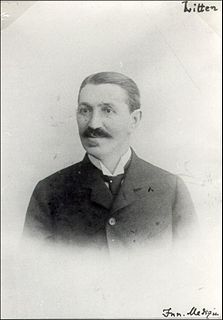Related Research Articles

Endocarditis is an inflammation of the inner layer of the heart, the endocardium. It usually involves the heart valves. Other structures that may be involved include the interventricular septum, the chordae tendineae, the mural endocardium, or the surfaces of intracardiac devices. Endocarditis is characterized by lesions, known as vegetations, which is a mass of platelets, fibrin, microcolonies of microorganisms, and scant inflammatory cells. In the subacute form of infective endocarditis, the vegetation may also include a center of granulomatous tissue, which may fibrose or calcify.

The tricuspid valve, or right atrioventricular valve, is on the right dorsal side of the mammalian heart, at the superior portion of the right ventricle. The function of the valve is to prevent back flow (regurgitation) of blood from the right ventricle into the right atrium during right ventricular contraction: systole.
The HACEK organisms are a group of fastidious Gram-negative bacteria that are an unusual cause of infective endocarditis, which is an inflammation of the heart due to bacterial infection. HACEK is an abbreviation of the initials of the genera of this group of bacteria: Haemophilus, Aggregatibacter, Cardiobacterium, Eikenella, Kingella. The HACEK organisms are a normal part of the human microbiota, living in the oral-pharyngeal region.

Mitral valve prolapse (MVP) is a valvular heart disease characterized by the displacement of an abnormally thickened mitral valve leaflet into the left atrium during systole. It is the primary form of myxomatous degeneration of the valve. There are various types of MVP, broadly classified as classic and nonclassic. In severe cases of classic MVP, complications include mitral regurgitation, infective endocarditis, congestive heart failure, and, in rare circumstances, cardiac arrest.

Infective endocarditis is an infection of the inner surface of the heart, usually the valves. Signs and symptoms may include fever, small areas of bleeding into the skin, heart murmur, feeling tired, and low red blood cell count. Complications may include backward blood flow in the heart, heart failure – the heart struggling to pump a sufficient amount of blood to meet the body's needs, abnormal electrical conduction in the heart, stroke, and kidney failure.

Aortic insufficiency (AI), also known as aortic regurgitation (AR), is the leaking of the aortic valve of the heart that causes blood to flow in the reverse direction during ventricular diastole, from the aorta into the left ventricle. As a consequence, the cardiac muscle is forced to work harder than normal.

Janeway lesions are rare, non-tender, small erythematous or haemorrhagic macular, papular or nodular lesions on the palms or soles only a few millimeters in diameter that are associated with infective endocarditis and often indistinguishable from Osler's nodes.
Roth's spots, also known as Litten spots or the Litten sign, are non-specific red spots with white or pale centres, seen on the retina and although traditionally associated with infective endocarditis, can occur in a number of other conditions including hypertension, diabetes, collagen vascular disease, extreme hypoxia, leukemia and HIV.
Libman–Sacks endocarditis (LSE) is a form of non-bacterial endocarditis that is seen in association with systemic lupus erythematosus (SLE), antiphospholipid syndrome, and malignancies. It is one of the most common heart-related manifestations of lupus.

Osler's nodes are painful, red, raised lesions found on the hands and feet. They are associated with a number of conditions, including infective endocarditis, and are caused by immune complex deposition. Their presence is one definition of Osler's sign.

Subacute bacterial endocarditis, abbreviated SBE, is a type of endocarditis. Subacute bacterial endocarditis can be considered a form of type III hypersensitivity.
Bracht–Wachter bodies are a finding in infective endocarditis consisting of yellow-white miliary spots in the myocardium.

Moritz Litten was a German physician who was a native of Berlin. He was a son-in-law to pathologist Ludwig Traube (1818–1876).
Bartonella quintana, originally known as Rochalimaea quintana, and "Rickettsia quintana", is a bacterium transmitted by the human body louse that causes trench fever. This bacterial species caused outbreaks of trench fever affecting 1 million soldiers in Europe during World War I.

Splinter hemorrhages are tiny blood clots that tend to run vertically under the nails. Splinter hemorrhages are not specific to any particular condition, and can be associated with subacute infective endocarditis, scleroderma, trichinosis, systemic lupus erythematosus (SLE), rheumatoid arthritis, psoriatic nails, antiphospholipid syndrome, haematological malignancy, and trauma. At first they are usually plum-colored, but then darken to brown or black in a couple of days. In certain conditions, clots can migrate from the affected heart valve and find their way into various parts of the body. If this happens in the finger, it can cause damage to the capillaries resulting in a splinter hemorrhage.
Kingella kingae is a species of Gram-negative facultative anaerobic β-hemolytic coccobacilli. First isolated in 1960 by Elizabeth O. King, it was not recognized as a significant cause of infection in young children until the 1990s, when culture techniques had improved enough for it to be recognized. It is best known as a cause of septic arthritis, osteomyelitis, spondylodiscitis, bacteraemia, and endocarditis, and less frequently lower respiratory tract infections and meningitis.

Cardiobacterium hominis is a Gram-negative bacillus (rod-shaped) bacterium commonly grouped with other bacteria into the HACEK group. It is one of several bacteria that is normally present in the mouth and upper part of the respiratory tract such as nose and throat. However, it may also rarely cause endocarditis, an infection of the heart valves.
Neisseria mucosa is a species of Neisseria.
Dental antibiotic prophylaxis is the administration of antibiotics to a dental patient for prevention of harmful consequences of bacteremia, that may be caused by invasion of the oral flora into an injured gingival or peri-apical vessel during dental treatment.
Suttonella indologenes, formerly Kingella indologenes, is a Gram-negative rod-shaped bacterium of the family Cardiobacteriaceae. Like other members of its family, it is a bacterium that is assumed to be normally present in the respiratory tract. It has been found to rarely cause endocarditis, an infection of the heart valves. It also been found in the eye. It may cause eye infections. Little is known about it as a bacterium other than its structure and biochemical composition. Like other members in its family, it has a characteristic 16S ribosomal RNA which consists of 1474 base pairs.
References
- ↑ "Infective Endocarditis: Practice Essentials, Background, Pathophysiology". 17 November 2017 – via eMedicine.Cite journal requires
|journal=(help)